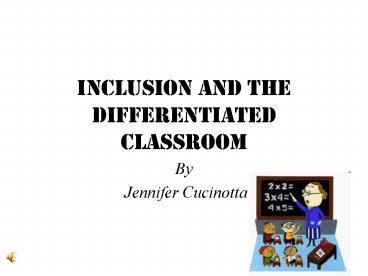Inclusion and the Differentiated Classroom - PowerPoint PPT Presentation
1 / 12
Title:
Inclusion and the Differentiated Classroom
Description:
We take in more information when we are ... Not all students are alike and acquire information the same way, therefore, ... Content and how to teach the content ... – PowerPoint PPT presentation
Number of Views:132
Avg rating:3.0/5.0
Title: Inclusion and the Differentiated Classroom
1
Inclusion and the Differentiated Classroom
- By
- Jennifer Cucinotta
2
How do we learn?
- We learn from new challenges
- We learn from each other
- We take in more information when we are young
- We all learn differently
- We learn by making connections
- Every brain is unique in its own way
3
What is Differentiation
- Not all students are alike and acquire
information the same way, therefore, teachers
need to adjust the curriculum to try and
incorporate different methods to meet the needs
of all learners.
4
Differentiation
- Multiple options for receiving information
- Incorporate different teaching methods
- Flexible
- Adjust curriculum
- Maximize each students growth and success
- Teachers should be involved and help in the
learning process
5
Differentiation in the classroom
- Teachers must pre-assess to know their students
background and prior knowledge - Put students into pairs or groups as needed
- It gives teachers an idea of students ability and
readiness for the lesson
6
Content and how to teach the content
- Teachers should know the state standards and
benchmarks for the grade level they teach - Teachers must set up a plan of how they are going
to teach
- Teachers can include
- Modeling
- Different modalities
- Independent or group work
- Practice Work
- Differentiate work for students
7
How to meet the needs of students
- The special needs students need modifications
(guided outlines,graphic organizers, word banks) - Provide time for re-teaching
- Provide visuals, manipulatives, clear directions,
and various ways of acquiring information - Appropriate grouping
- Challenge and assist ALL students
- Provide high-level thinking
- Write thorough explanations
- Make connections
8
Assess
- Teachers need to make sure their students are
acquiring the information being taught - Evaluate
- Observe
- Writing Samples
- Worksheets
- Rubrics
9
Inclusion
- Two teachers working together to deliver
instruction to a class of students with different
needs
10
Collaborative teaching
- Flexible
- Provides support for students
- Work together
- Share instructional time
- Both teachers work with all students
- Collaborate and modify curriculum
11
Different Methods
- Supportive teaching (One teacher instructs and
the other teacher assists students while walking
around) - Parallel teaching (Class is split into two groups
and each teacher instructs a group) - Station Teaching (Independent stations and each
teacher monitors a different station) - Alternative Teaching (One teacher leads lesson
and the other teacher pulls small groups)
12
Inclusion in the Classroom
- Teachers rotate roles
- Teachers are responsible for all students
- Common planning time
- Differentiate assignments so all students can
work to their challenging level - Support system for all































